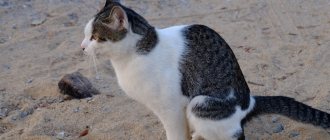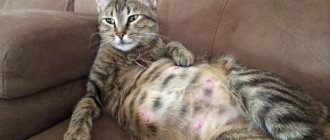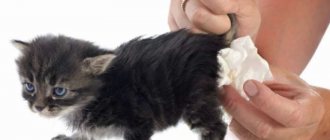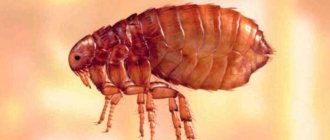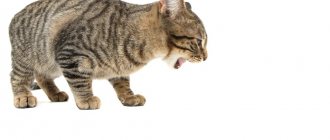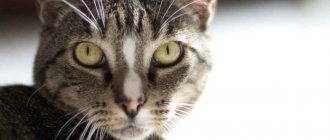Like many cat owners, cleaning your cat's litter box probably isn't your favorite thing to do (but if it's not, we'd love your help!). But did you know that to keep your cat healthy, it is quite important to check whether her poop is of normal color and shape?
Most animals defecate at least once a day, and a cat's stool is an excellent indicator of its health. By its appearance, you can determine whether she has constipation or any other disease, and whether her food is suitable for her.
Knowing what a “good poop” should look like will help you recognize if your cat's stool doesn't look quite normal.
Healthy and Unhealthy Cat Stool: What to Look for
Typically, a healthy cat's poop is fairly pliable (like modeling clay: not too soft, not too hard) and oblong in shape—like a candy bar. This is considered the "gold standard" for excrement. Normal stool is dark brown in color, but not too dark, as dark or even color may indicate the presence of digested blood in the stool. Poop that is too light could indicate a more serious problem, such as liver disease, as it could be a sign of a completely blocked bile duct, says PetWave.
Stool in the form of small, hard balls is considered abnormal and may be a sign of constipation. This is a serious problem for cats because it can indicate health problems such as neurological or metabolic diseases or colon obstruction, notes International Cat Care. According to Wag! Constipation in your cat may also indicate that she is dehydrated. You should definitely contact your veterinarian if your cat is defecating small, hard pellets.
You should also look for unformed, soft or almost liquid stools with mucus without any obvious shape. Diarrhea in cats can be caused by a variety of causes, from bacterial infections to intestinal parasites and food intolerances. If you do not look closely at the contents of the tray, sometimes you can mistake very liquid stool for urine. So always take a close look at what you're scooping out of the litter in the tray—or you can even use a pair of disposable gloves to check the texture.
Not every unusual cat poop is a cause for panic, but it still requires careful observation. Your cat may have diarrhea for one to two days after a change in diet or a heavy car ride, notes Cornell University's Feline Health Center. However, if such stool lasts more than two days or is accompanied by poor appetite, lethargy, or vomiting, take your pet to a veterinarian immediately, says Dr. Richard Goldstein of Cornell University. It's always better to be safe than sorry.
Causes of changes in stool color
White or light-colored cat feces warns of the possible presence of a dangerous pathology in the animal’s body. At the same time, the frequency and nature of bowel movements may change.
In the small intestine, feces are colored brown by bile. If the secretion of this physiological fluid is impaired, then the stool is light in color.
Veterinarians identify the following causes of white stool in cats:
- Cholelithiasis. It is a consequence of feeding your pet low-quality, cheap food. Along with it, urolithiasis is often detected. The bile ducts become clogged with sand and stones. Bile continues to be produced, but cannot leave the gallbladder. This can lead not only to digestive disorders, but also to organ rupture.
- Neoplasms in the liver, gall bladder and ducts. Cysts, benign or malignant tumors often cause disruption of the outflow of bile.
- Cirrhosis. Liver cells begin to degenerate. The pathological process is irreversible. With the help of timely therapy, you can prolong and make your pet’s life easier.
- Atony of the gallbladder. The walls of the organ are weak, stretched and soft. They do not contract and do not push bile into the ducts. This may result in organ rupture.
- Deformation of the ducts. The pathology can be congenital and affect the appearance of stool.
- Inflammatory processes in the liver. Most often they are observed with hepatitis and cholangitis.
If the animal has white feces only once, the reason may be due to diet. This happens when there is an excess of phosphorus in the body. Light-colored feces are normal after a pet has eaten a lot of fish (especially river fish). However, the owner must understand that this type of diet is unacceptable for an obligate predator.
How to Prepare Cat Stool Samples for Testing
At each annual exam, your veterinarian may ask you to bring a stool sample for laboratory testing. It is best to collect samples in special plastic containers, which can be purchased at both a veterinary and a “human” pharmacy. Just remember: the lab needs a fresh sample, so collect these “treasures” from the tray the day of your veterinarian visit. Once you collect the feces in an approved plastic specimen container, be sure to sign the date and time of collection so that your veterinarian has accurate information.
What treatment is prescribed?
Medication
Depending on the diagnosis, the veterinarian selects the most optimal treatment regimen, which often includes the following groups of drugs:
Dicynone is able to stop a minor source of bleeding in an animal.
- Hemostatic. If diagnostics show that the cat is developing internal bleeding, but it is not life-threatening, the doctor will prescribe medications that can prevent the loss of vital fluid. Effective drugs in this group: “Dicinon”;
- "Tranexam";
- "Vikasol".
- "Penicillin";
- "Interferon";
- "Pyrantel";
- "Maalox";
Surgical
Sometimes surgery is the only option for an animal to return to normal.
Sometimes it is impossible to normalize a pet’s condition with medications alone, for example, with heavy internal bleeding. To save the animal's life, the doctor decides to perform surgical treatment. The manipulations are performed under general anesthesia. After the operation, a long recovery will be required, during which it is important for the owner to control the diet of his four-legged friend, as well as give him medications prescribed by the doctor to prevent the development of inflammatory processes and increase the body's defenses.
Several cats - several checks
If you have more than one cat, it is not necessary to collect samples for each individual animal unless your veterinarian asks you to do so. However, if you find blood in the stool, you will likely need to watch the litter box to determine which cat has a health problem. Of course, if one cat is sick, the rest may also be sick. If you notice a serious problem with one cat, try to isolate her and her litter box from the rest of the cat until you can take her to the veterinarian.
Believe it or not, your cat's stool can tell you a lot about how she's feeling. By checking it with your daily litter box cleaning, you can monitor and maintain her health and provide her with a clean, healthy environment.
Light-colored stool - observation and diagnosis
White and light-colored feces in cats require a quick response, and the animal’s vital activity should be monitored.
- What kind of food does the cat have, does it ask for water.
- How much does a cat eat and drink per day?
- How many times does the cat visit the litter box, what is the nature of its bowel movements?
- Features of cat behavior during defecation.
Two or three days of observing the animal and passing the necessary tests will help the veterinarian determine the cause of the change in feces, and therefore establish the correct diagnosis and prescribe the correct treatment.
List of tests recommended by your veterinarian when your cat has white stool:
- general blood analysis;
- blood for biochemistry;
- analysis of feces and urine;
- ultrasound of internal organs;
- X-ray;
- biopsy.
Testing the animal's blood and feces will allow the specialist to assess the animal's overall health. Special laboratory tests will tell you which organ the pet has problems with. Ultrasound examination helps to identify neoplasms, displays pathological degeneration of healthy tissues, and shows stones and sand in the ducts.
Treatment in the clinic
Important! If diarrhea does not go away within 1-2 days, then you should immediately contact a veterinarian, since the kitten’s body obviously cannot cope with the pathology on its own.
A doctor can seriously help you:
- First of all, a microscopic examination of a stool sample is carried out and cultured on nutrient media. Stool samples are taken for culture before starting antibiotics, otherwise the results of the study will be distorted.
- In case of bacterial infection, antibiotics are prescribed, which are selected based on the type of microbe.
- In case of viral infection, antiviral drugs are prescribed, which are also selected based on the strain of the virus.
- If it turns out that the cause of diarrhea is parasitic worms, anthelmintic (anthelminthic) drugs are prescribed.
- For diarrhea caused by poisoning, the toxin is determined and antidotes are applied (if available). There are cases when there is a suspicion of poisoning, but it is impossible to determine the toxin. Then symptomatic treatment is applied. Intoxication is relieved by intravenous administration of buffer compounds. A blood transfusion is prescribed, which can only be done in advanced veterinary clinics that have a blood bank.
- If the animal's general condition improves, it is prescribed a light diet for 14 days, after which the kitten is gradually returned to its normal diet.
What else can accompany white feces?
Any deviations in the color of feces and their consistency indicate dysfunction of the gastrointestinal tract and bile-hepatic system:
- Feces with a white coating, especially if it has a loose consistency, may indicate an excess of stringy meat products and bones in the diet.
- White feces with a liquid consistency are usually observed with liver pathologies, pancreatic enzyme deficiency, and irritable bowel syndrome.
- White-cloudy mucus indicates diseases of the large intestine. Also, such a symptom can be observed when infected with helminths - in such cases, white worms can be found in the feces.
- If white grains are found in the stool, the cat should be checked for worms, fungi of the genus Candida in the digestive tract, and the stool should be tested for digestion. White spots in the stool may be undigested food debris. Sometimes white spots can develop into small white worms - a clear sign of helminthic infestation.
Associated symptoms of diarrhea in cats
In addition to loose green stools, the following symptoms may indicate diarrhea::
- Increased body temperature.
- Change in animal behavior.
- The cat is thirsty all the time.
- The pet's body weight decreases.
- The quality of the cat's fur becomes poor.
- The mucous membranes of the animal turn pale.
- Appetite disappears.
© shutterstock
Green stool in a kitten with a liquid consistency, turning into a chronic condition, leads to dehydration of the animal’s body and the accumulation of toxins in it. In this case, metabolic processes are disrupted. The kitten's growth and development slow down.
Causes of diarrhea
It is difficult or impossible to make a diagnosis without instrumental examination and laboratory blood tests in most cases. Jaundice and pain in the right hypochondrium indicate problems with the liver, but will not provide information about the exact causes.
Possible causes of diarrhea:
- Liver cancer (an extremely rare occurrence in small kittens).
- Diabetes mellitus or diabetes insipidus.
- Viral or bacterial infection.
- Infection with helminths.
- Severe stress.
- A sudden change in diet.
- Distribution of medical supplies.
- Food poisoning.
- Lactose intolerance.
- Binge eating.
As you can see, there can be many reasons; in any case, you should immediately contact a veterinarian.
What should a cat owner do first?
White feces in a cat - what to do? Doing anything on your own in terms of medication intervention is highly not recommended. You only need:
- over the past few days, analyze what and how Murka was fed;
- adjust feeding if nutritional disturbances are detected;
- monitor over the next few days whether there is a change in the color of the stool towards darkening;
- if a change in feeding does not lead to the restoration of the color of the stool, you should visit a veterinarian, preparing as detailed an anamnesis as possible (information about the keeping and feeding of the animal, prior to the lightening of the stool);
- If white worms are found in a cat’s feces, the feces should be submitted for parasitic analysis.
If stool lightening is simultaneously accompanied by refusal to eat, general weakness, apathy or, conversely, anxiety, diarrhea or constipation, as well as changes in body temperature (in any direction), then a visit to the veterinary clinic cannot be postponed!
